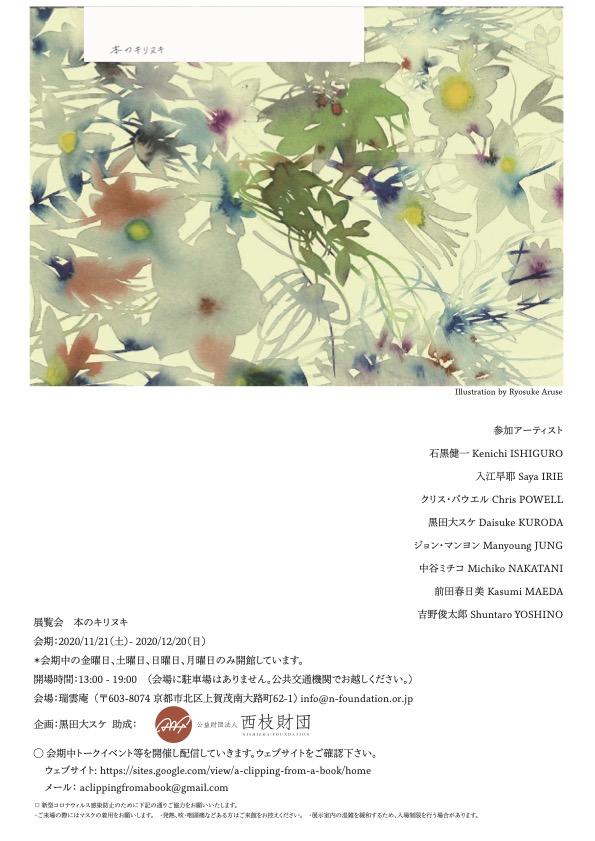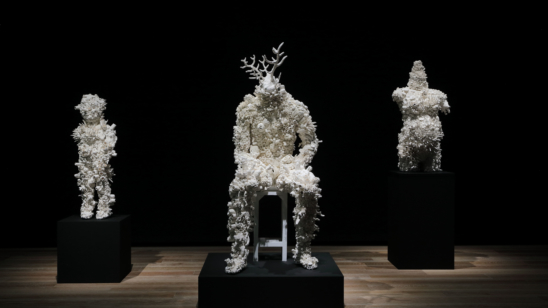Hon no kirinuki (A clipping from a book)
This exhibition focuses on information pertaining to sculptures. In recent years, the producer has conducted research on international students at the Faculty of Sculpture at the Tokyo School of Fine Arts in the 1930s regarding the spread and expansion of East Asian concepts about sculpture, while also creating works himself. What was discovered during the process was that it was more common for sculpture to be shared widely throughout East Asia after having been replaced by words, simplified images, and other forms of secondary information than it was to be shared as actual sculptures. For example, during the period of material scarcity in Korea following the Korean War, all artists are said to have gathered together in the large port city of Busan in order to obtain Bijutsu Techo magazines and other old books about art so that they could obtain information about fine art in the world through the photographs and passages that they contained. This situation overlaps with the attitude in Japan toward Western art, and it can be thought that secondary information about sculpture contained in magazines, newspapers, and other forms of writing have been accepted as sculpture and have had more of an effect than the sculptures themselves. This exhibition is about sculptures and their secondary information and explores the potential of new expressions in sculpture in the modern age by dissecting old views on sculpture based on the theory that “sculptures are information about sculpture”, while revisiting the acceptance and development of sculpture in modern East Asia for clues.
There will be eight participating artists: Kenichi Ishiguro, Saya Irie, Chris Powell, Daisuke Kuroda, Man-Young Jung, Michiko Nakatani, Kasumi Maeda, and Shuntaro Yoshino. Broadly speaking, the exhibition will be comprised of three sections. The first section will focus on the value and aesthetic sense of three-dimensional objects as a premise for discussing sculpture. Ishiguro’s documents about the rai stones on the Yap islands and Powell’s found objects, which can be mistaken for stoneware, will be featured. In the second section, we will observe how modern Japanese concepts about sculpture have been derived from East Asian countries and formed from the Meiji era to the present from the practical experience of artists who cross the boundaries of expression through sculpture. This section will feature a video which was produced based on Kuroda’s research on East Asian concepts of sculpture, three-dimensional works created by Irie based on images from old art notebooks as if to imitate the behavior of sculptors, reliefs by Nakatani which take on flatness as a result of even stronger expressions of sculpture, and a sound installation by Jung that represents the diversity of expressions of sculpture by elevating the relationship between the environment (sounds) and the body into a sculpture. In the third and final section, we will explore the present and future possibilities of expressions of sculpture in a society in which computers and the internet have become popularized. This will be in the form of an installation created through joint production by Maeda and Yoshino, who are participating artists from a relatively young generation.
In modern times, when indirect communication on the internet has become popularized as a result of the spread of novel coronavirus infections, communication based on secondary information that does not involve encounters with somebody or something has become commonplace. It is no longer rare for things to be completed with secondary information only despite the lack of a subject, and perhaps the theory that “sculptures are information (images, text, etc.) about sculpture” which this exhibition presents can be considered something that is obvious and not particularly special. Under these circumstances, this exhibition aims to become an opportunity to formulate new expressions of sculpture and a practical history of sculpture by reexamining the artistic expression of sculpture that was produced in Japan’s modern steps that began with imperialism through reviewing and spreading concepts of sculpture using the hypothesis of “sculptures are information about sculpture” as a clue.
- Artist
- Chris Powell Kenichi Ishiguro Daisuke Kuroda Saya Irie Michiko Nakatani Man-Young Jung Kasumi Maeda Shuntaro Yoshino
- Supported by
- Nishieda Foundation
- Venue
- Zuiunan



